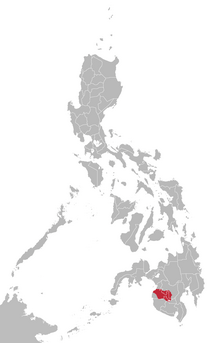Maguindanao language
| Maguindanao | |
|---|---|
| Native to | Philippines |
| Region | Southwest Mindanao |
| Ethnicity | Maguindanao |
Native speakers | 1.1 million (2010)[1] |
Language family | Austronesian
|
Writing system | Latin; Historically Jawi |
| Official status | |
Official language in | Regional language in the Philippines |
| Regulated by | Komisyon sa Wikang Filipino |
| Language codes | |
| ISO 639-3 | mdh |
| Glottolog | magu1243 |
 Area where Maguindanaon is spoken | |
Maguindanao or Maguindanaon is an Austronesian language spoken by a majority of the population of Maguindanao province in the Philippines. It is also spoken by sizable minorities in different parts of Mindanao such as the cities of Zamboanga, Davao, and General Santos, and the provinces of North Cotabato, Sultan Kudarat, South Cotabato, Sarangani, Zamboanga del Sur, Zamboanga Sibugay, as well as Metro Manila. This was the language of the historic Sultanate of Maguindanao, which existed before and during the Spanish colonial period from 1500 to 1888.
Background[]
This section needs expansion. You can help by . (October 2020) |
The Maguindanao language is the native language of the Maguindanao people of the province of Maguindanao located in the west of Mindanao island in the south of the Philippines. It was the language of the Sultanate of Maguindanao, which lasted until near the end of the Spanish colonial period in the late 19th century.
The earliest works on the language by a European were carried out by Jacinto Juanmartí, a Catalan priest of the Society of Jesus who worked in the Philippines in the second half of the 19th century.[2][3] Aside from a number of Christian religious works in the language,[5] Juanmartí also published a Maguindanao–Spanish/Spanish–Maguindanao dictionary and reference grammar in 1892.[6] Shortly after sovereignty over the Philippines was transferred from Spain to the United States in 1898 as a result of the Spanish–American War, the American administration began publishing a number of works on the language in English, such as a brief primer and vocabulary in 1903,[7] and a translation of Juanmartí's reference grammar into English in 1906.[8]
A number of works about and in the language have since been published by both local and foreign authors.
Phonology[]
Consonants[]
| Labial | Alveolar | Palatal | Velar | Glottal | ||
|---|---|---|---|---|---|---|
| Plosive | voiceless | p | t | k | ||
| voiced | b | d | ɡ | |||
| Nasal | m | n | ŋ | |||
| Fricative | s | h | ||||
| Rhotic | ɾ ~ r | |||||
| Lateral | l | |||||
| Approximant | w | j | ||||
Other consonant sounds /ʒ, z/ are also used, but only as a result of Arabic loanwords.[9]
Vowels[]
| Front | Central | Back | |
|---|---|---|---|
| Close | i | u | |
| Mid | ə | ||
| Open | a |
See also[]
- Languages of the Philippines
References[]
- ^ Maguindanao at Ethnologue (18th ed., 2015)
- ^ "Juanmartí, Jacinto, S. I. (1833-1897)". Biblioteca Virtual de la Filología Española (in Spanish). Retrieved 2020-10-10.
- ^ Jump up to: a b Aguilera Fernández, María (2018). "Literatura misional y hagiografía en el siglo XIX: Jacinto Juanmartí, un misionero jesuita en Filipinas (1833–1897)" [Missionary literature and hagiography in the 19th century: Jacinto Juanmartí, a Jesuit missionary in the Philippines (1833–1897)]. Hispania Sacra (in Spanish). 70 (141): 321. doi:10.3989/hs.2018.024.
- ^ i.e., Compendio de historia universal desde la creación del mundo hasta la venida de Jesucristo y un breve vocabulario en castellano y en moro maguindanao [Compendium of universal history from the creation of the world to the coming of Jesus Christ and a brief vocabulary in Spanish and Moro-Maguindanao] (in Maguindanao and Spanish). Singapore: Koh Yew Hean. 1888.CS1 maint: unrecognized language (link)
- ^ such as a Maguindanao–Spanish bilingual "sacred history", with a short wordlist, in 1888,[4][3] in which Maguindanao was written in both Arabic characters and the Latin alphabet
- ^ i.e., Juanmartí (1892a) and Juanmartí (1892b)
- ^ i.e., Porter (1903)
- ^ i.e., Juanmartí (1906)
- ^ Racman, Tenex; Zorc, R. David (2009). Maguindanaon: Dialogs and Drills (PDF). Dunwoody Press.
Bibliography[]
- Juanmartí, Jacinto (1892a). Diccionario moro-maguindanao-español [Moro-Maguindanao-Spanish dictionary] (in Spanish). Manila: Tipografía «Amigos del País».
- Juanmartí, Jacinto (1892b). Gramática de la lengua de maguindanao según se habla en el centro y en la costa sur de la isla de Mindanao [A grammar of the Maguindanao tongue according to the manner of speaking it in the interior and on the south coast of the island of Mindanao] (in Spanish). Manila: Tipografía «Amigos del País».
- Juanmartí, Jacinto (1906) [First published in Spanish 1892]. A Grammar of the Maguindanao Tongue According to the Manner of Speaking It in the Interior and on the South Coast of the Island of Mindanao. Translated by Smith, C. C. Washington: Government Printing Office.
- Porter, R. S. (1903). A Primer and Vocabulary of the Moro Dialect (Magindanau). Washington: Government Printing Office for the Bureau of Insular Affairs.
External links[]
- Danao languages
- Languages of Maguindanao
- Philippine language stubs
